Marcopolo
Asteroid Sample Return

2D MarcoPolo
2D Sample analysis
MarcoPolo 2D will allow us to analyse samples of a primitive near Earth asteroid in terrestrial laboratories, thereby obtaining measurements that cannot be performed from a robotic spacecraft. For example, the dating of major events in the history of a sample: Laboratory techniques can determine the time interval between the end of nucleosynthesis and agglomeration, the duration of agglomeration, time of accumulation, crystallisation age, the age of major heating and degassing events, the time of metamorphism, the time of aqueous alteration, and the duration of exposure to cosmic radiation. One of the main objectives of these analyses is the identification and characterisation of organic materials, which may have contributed to the origin of life on Earth. Another major goal is understanding the volatile inventory of such a primitive body, characterising the isotopic signatures of the volatile components to identify the origin of the volatile components and whether such bodies played a major role in the delivery of water and other volatiles to the early Earth.
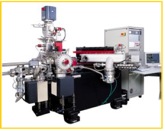
NanoSIMS
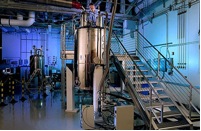
NMR
In almost all cases, no single measurement, or type of measurement, will provide the complete answer to any of the questions. Instead, our understanding will be derived from the results of many analyses of different components of the returned samples, and by a plethora of techniques. The figure below shows the example of an instrument and related measurements that can be done to infer absolute ages.
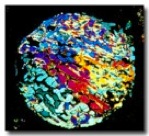
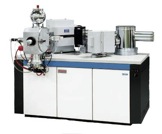
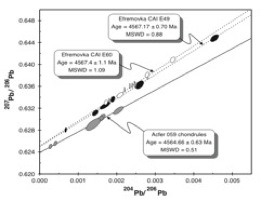 Absolute ages for the formation of solar nebula components, i.e. Calcium, Aluminium-rich Inclusions (CAIs) and chondrules (above right), can be determined by radiometric dating techniques. This requires very specialised mass spectrometer systems such as thermal ionisation mass spectrometry (TIMS, above left) or inductively coupled plasma mass spectrometry (ICPMS) to provide the high levels of precision, sensitivity and mass resolution for the accurate isotope ratio measurements of trace elements such as Pb (left). Analyses of sub-samples permit ages of more than 4.5x109 years with uncertainties of less than 106 years to be acquired. Images courtesy Univ. Hawaii and Norton and Toffoli. Data from Amelin et al. 2002.
Absolute ages for the formation of solar nebula components, i.e. Calcium, Aluminium-rich Inclusions (CAIs) and chondrules (above right), can be determined by radiometric dating techniques. This requires very specialised mass spectrometer systems such as thermal ionisation mass spectrometry (TIMS, above left) or inductively coupled plasma mass spectrometry (ICPMS) to provide the high levels of precision, sensitivity and mass resolution for the accurate isotope ratio measurements of trace elements such as Pb (left). Analyses of sub-samples permit ages of more than 4.5x109 years with uncertainties of less than 106 years to be acquired. Images courtesy Univ. Hawaii and Norton and Toffoli. Data from Amelin et al. 2002.